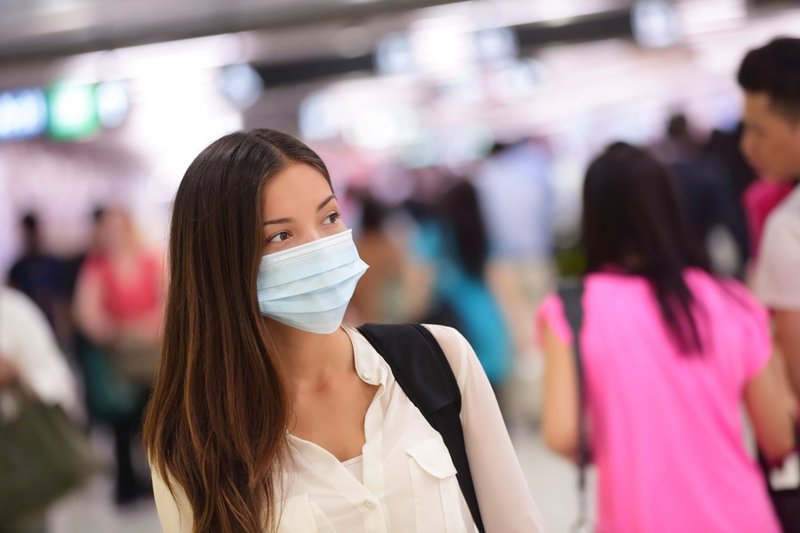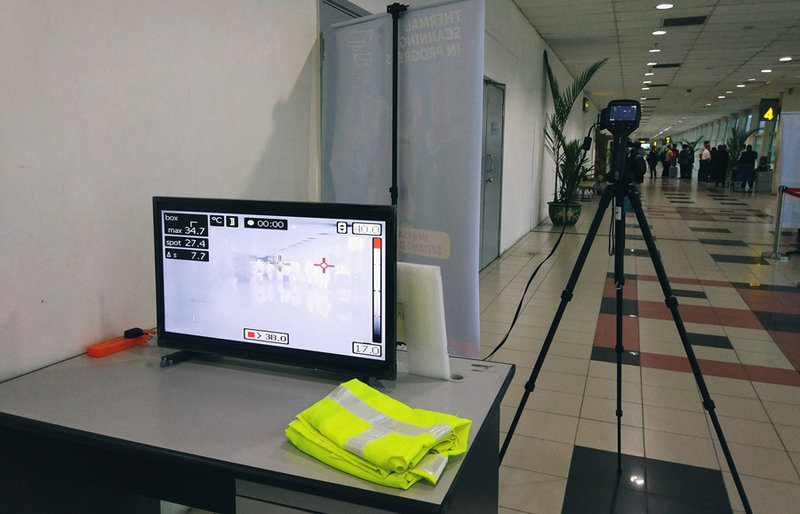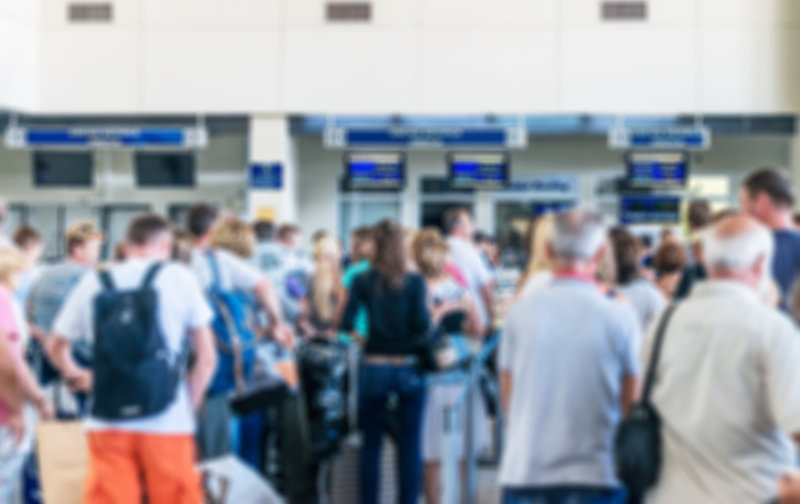Terminal operations
The travel bug: preventing disease at airports
The
future
of US air
traffic control:
the third option?
Air travel increases the likelihood of infectious diseases spreading rapidly between countries and continents. Why are airports such havens for pathogens, and what can they do to combat this? Joe Baker finds out
G
lobal concerns about diseases such as swine flu and Ebola have led to an increasing number of airports going under the microscope. As global connectivity has increased, so too has the potential for high-threat pathogens to spread through airports.
Statistics show that the number of scheduled passengers handled by the airline industry in 2017 was more than four billion, and is set to almost double by 2036. That means even more passengers mulling around, breathing the same air and unconsciously depositing who-knows-what on heavily used surfaces.
“Airports are connected all around the world,” says Ilpo Kulmala, a research scientist at the VTT Technical Research Centre in Finland. “They are a means of spreading diseases around the world quickly.”
In an age when the fear of pandemics is being fuelled by outbreaks in West African countries and beyond, what can airports do to combat the spread of pathogens and disease?
Image courtesy of
The role of airports in spreading pandemics
Scientists have put forward studies with two primary aims: identifying where the risk lies for disease transmission and taking effective steps to eliminate that risk. One finding has been that bacteria might not always appear in the most obvious places at airports.
British and Finnish researchers collected samples from frequently touched surfaces at Helsinki-Vantaa airport during peak flu seasons in 2015 and 2016. They found that during these periods, half of the plastic luggage trays at airport security were found to be harbouring at least one respiratory disease, such as influenza or the common cold.
Another study commissioned by Insurance Quotes found that self-check-in kiosks – featuring touchscreens – can contain up to 253,857 bacteria or colony-forming units (CFU) across a square inch of their surfaces. When compared to the 172 CFU generally found on a toilet seat, passengers should revaluate where to be careful at today’s tech-filled aviation hubs.

The Helsinki-Vantaa study was carried out under the auspices of PANDHUB, an EU-funded project that aims to help transport hubs develop pandemic preparedness and response plans. The project has involved numerous activities, including using technology to model the spread of disease in transport environments and investigating cleaning practices.
“The main finding was that it’s a multidiscipline approach,” says Kulmala. “We need to involve several actors in the feat, including the operators and public health authorities and other actors at the airport.
“There are so many different kinds of threats. It’s hard to find a single solution for possible cases – so I think raising awareness and threat analysis could reveal the most risky areas of airports with respect to some specific disease.”
Eero Knuutila is Head of Service Development at Helsinki Airport.
Image courtesy: Helsinki Airport
There are so many different kinds of threats, it’s hard to find a single solution for possible cases
Discovering infected passengers at airports
One of the major issues is that methods for surveying and monitoring infected passengers are still imperfect. Different strategies range from a standard questionnaire format (i.e. asking passengers whether they have come into contact with infected persons or objects) to infrared-based temperature monitors and thermal scanners.
Kulmala says these measures are often ineffective because some passengers might not display symptoms when they are screened and interviewed, but might develop them later on.
“Even with a severe infection, you can simply take an aspirin or ibuprofen and you can lower your body temperature,” says Fraunhofer Institute for Cell Therapy and Immunology research scientist Dirk Kuhlmeier.
“One great alternative would be a molecular biological method, which is the best solution for the detection of infectious diseases. However, they would need standard laboratories and require too much time – three to four hours. Additionally, the costs are in the range of euros per sample.”
Kuhlmeier is currently working on the HyFly joint research project, which is being funded by the German Federal Ministry of Education and Research Infect Control 2020 initiative. A key part of the project has been finding a way to quickly detect infections during passenger screening, without using molecular biological methods.
Fraunhofer researchers are developing a non-invasive system that could quickly distinguish types of bacteria based on volatile organic compounds (VOC), which are contained within a passenger’s breath. They say the new ion mobility spectrometry system would be non-invasive and that this technology has been shown to work in other areas, such as drug and explosives detection.

Kuhlmeier says scientists have been able to detect different bacteria types under lab conditions and the next step will be to bring the device to clinical patients (and eventually flight passengers) in 2019. However, a major challenge with the device – one that will require further study – will be the potential for ‘food interference’ when it comes to detecting VOCs.
“Imagine somebody is eating Chinese food, another person Indian - their breath would have a completely different composition,” says Kulhmeier. “With our device, you analyse VOCs, which are metabolites from bacteria as well as humans. A major challenge is the differentiation between bacterial and human ‘smells’.”
Another outcome of the HyFly project will be the development of 'concrete action plans' for airport operators to combat diseases. Kuhlmeier says this could involve new cleaning procedures for planes and airports, antimicrobial coatings for handrails, and measures for detecting infections earlier.
Methods for surveying and monitoring infected passengers are still imperfect
What can airports do in the meantime?
What should airports be doing in the meantime? The answer appears to be using a healthy dose of common sense. Specifically, airports should use signage to ensure passengers are aware of the risks of spreading infections, as well best practices such as hand washing, and make sure plenty of hand sanitizer is available.
“Infections can spread mainly through the air or by touching things,” says Kuhlmeier. “Automatic doors can be a simple, obvious concept to enable passengers to walk through an airport without touching too many things. Additionally, the instalment of hand disinfection areas in arrival zones is helpful.”
Many major airports don’t need convincing when it comes to keeping clean, given the impression they want to leave on passengers. An Airport Council International (ACI) report published earlier this year found that washroom and terminal cleanliness affects overall passenger satisfaction more than any other infrastructure factor.

“The situation at the airports is quite good from a hygienic point of view – as least as safe as other public places – but during pandemics there are people around who may carry these diseases, and that's why we are preparing for it,” says Kulmala.
Technology is also providing a boost in this area. Last year, Ohio’s Akron-Canton Airport partnered with NanoTouch Materials to introduce new custom-designed ‘NanoSeptic’ mats and skins for security checkpoint trays. The mats continuously break down contaminants through a self-cleaning oxidation reaction. This October, NanoTouch Materials announced it was manufacturing a self-cleaning film that could be applied on touchscreens – a staple of self-check-in kiosks and in-flight entertainment systems.
Meanwhile, Hartfield Jackson International Airport in Atlanta, US, has invested in TRAX SmartRestroom software. Sensors fitted in bathrooms at the airport keep count of the number of passengers using facilities, and send an email alert to supervisors when it’s time for a clean-up.
Eero Knuutila is Head of Service Development at Helsinki Airport.
Image courtesy: Helsinki Airport
Many major airports don’t need convincing when it comes to keeping clean
Could further regulation help?
According to the World Health Organization website, international health regulations introduced in 2005 “contain obligations of States Parties in relation to routine prevention and control measures and response to events at designated airports that may constitute a public health event of international concern”.
Kulmala says that although existing guidelines could be improved, updating regulations regarding disease preparation could be difficult, due to the varied nature of diseases and the pathogens that cause them.

Image courtesy of
“There are general guidelines but not very specific ones,” he says. “Specific guidelines depend on the nature of the disease, so if they were to be regulated more strictly, then rules should be targeted towards some specific disease.
“That could be quite complicated, because the properties of these viruses – for example, influenza – change. Therefore doing very detailed guidelines is difficult. It must be done on more like a case-by-case basis.”
Specific guidelines depend on the nature of the disease